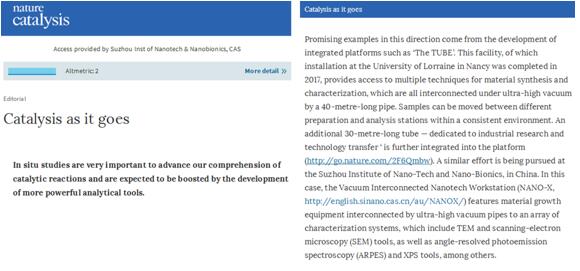On Mar. 8th, 2018, Nature Catalysis, as one academic journal of Nature publishing press, published an editorial "catalysis as it goes ", expounded the history of catalysis science, analyzed and forecasted the future trend of catalysis research. Especially, this article specified that vacuum interconnected nanotech workstation (NANO-X) plays an important role in the development of catalytic research in the near future, and gave a very positive comment on the necessity and significance to establish such a platform.
This editorial pointed out that characterizing a catalytic process is a complex and yet crucial task. The generated information has a large impact on the practicality of a given process and provides insights that can lead to further optimization of any corresponding industrial application. On one side, changes in the composition of reagents and products have to be followed over time in order to define the kinetic parameters of the process; on the other, the evolution of the catalyst’s structure must be followed to gain. Although the reactants and catalyst can be studied independently, it is their interplay that determines the overall outcome of a reaction. And the existence of differences between a catalyst out of its working environment and a catalyst in action is largely supported by experimental data. This is why we study them when they are together: in situ.
However, comprehensive understanding of catalytic process requires multi-scale research methods. NANO-X is a promising example to illustrate the advantage of integrated or interconnected analytical instruments in catalysis research. As each characterization tool can only provide specific and partial information, while taking advantage of an array of characterization systems interconnected by ultra-high vacuum pipes, multiple characterization can be performed on a single sample excluding the contamination step through air. And these tools may not all provide in situ characterization, but through vacuum interconnection, together with in situ techniques will drive our understanding of catalysis as it goes.
NANO-X is jointly established by Suzhou Institute of Nano-Tech and Nano-Bionics (SINANO), Chinese Academy of Sciences (CAS) and Dalian Institute of Chemical Physics (DICP), CAS as well as Tsinghua University. The primary goal is to make breakthroughs in basic research and industrial application of nanoscience, and to be built as the first large scale scientific facility integrating multiple techniques for material synthesis, device fabrication and characterization. NANO-X will be the most advanced and open platform for nanomaterial research and device fabrication. Several to-be-verified projects are included in the first construction stage in NANO-X, they are III-V semiconductor materials and manufacturing technology, basic research and new device development of low-dimensional high-temperature superconducting materials, research and application of nano catalysis and new energy materials, new materials for lithium battery storage and so on. Among them, the project “nano catalysis and new energy materials” is collaborated with Xinhe Bao’s group from DICP. This project is featured by the in situ characterization techniques in near ambient pressure ranges, and expected to help getting a comprehensive understanding on catalytic reaction process through other vacuum interconnected characterization systems. Yi Cui, a research professor sponsored by “the Thousand Young Talents Program”, is responsible for nano catalysis research and collaboration in SINANO. Domestic and overseas collaboration are sincerely welcome.

(Information Source: SINANO, CAS)

